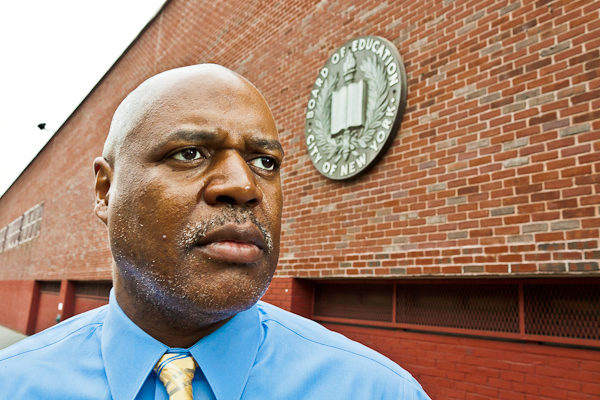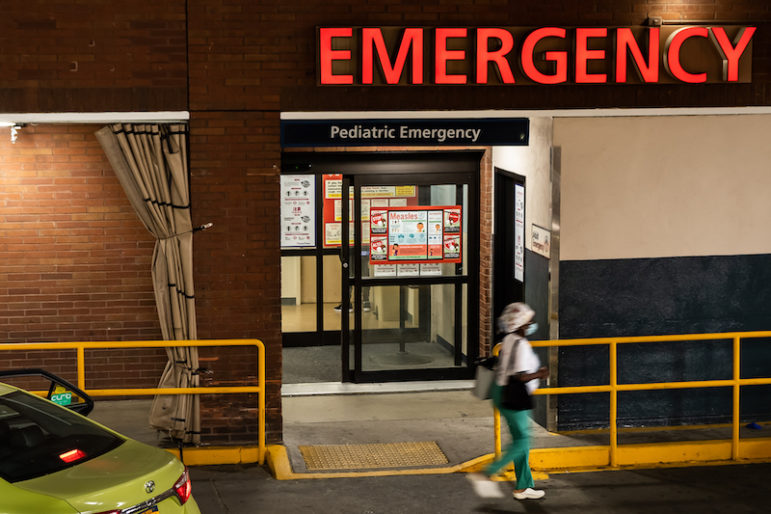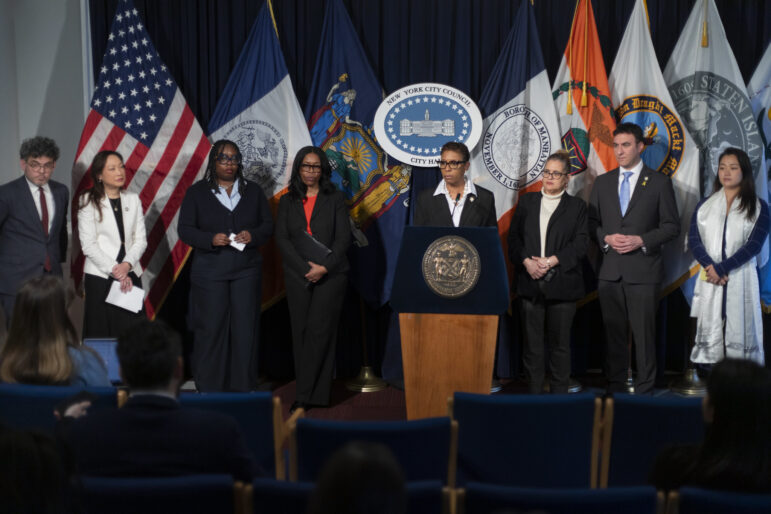
Photo by: Adi Talwar
Bernard Gassaway is in his third year as principal at Boys and Girls. He was a teacher there from 1988 to 1991.
On a recent weekday morning, Bernard Gassaway, principal of Boys and Girls High School, bounced casually down the stairs while giving a tour of the building to a new guidance counselor. As the tour was coming to a close, the atmosphere along the path he took back toward his office was suddenly ripe for a fight: In a busy stairwell, an agitated guard had tried to stop an angry student for some offense. Gassaway watched the boy jerk his backpack away from the guard and retreat up the stairs, his face full of rage.
Gassaway casually made his way toward the student, grabbed him and put him in a playful headlock, an ironic demur of the aggressive manner in which the guard seemed to be handling the situation.
“Did you grab him like this?”
Unable to maneuver, the kid just smiled.
“I didn’t do nothing to him,” barked the guard, who, for his part, was still irritated. As if to stick up for his friend, another student then stepped to Gassaway.
“What, I grab him and you show up? I got people, too.” He winked at his new hire.
He disguised it with playful banter, but Gassaway was in a solemn mood. Earlier that morning, rising before the sun, he stopped by the Jamaica, Queens home he once lived in with his ex-wife, Traci, and daughter, Atiya. There are still pieces of his life there, loose ends that need tying. The home is in contract to be sold. “I’m not going to fool myself,” he replied when asked how he was doing personally. “I think I’m OK. I know that you’ve got to take care of yourself before you take care of others. And I haven’t always done that.”
It was during the first school days of September of 2009 that Gassaway and his ex-wife began their difficult separation. The freshman class that arrived then will be seniors when the 2012-2013 school year begins in September. And yet, while his tenure reaches what he says is an emotional milestone, there’s a growing weight to the long-held fear that the Department of Education could elect to phase-out or close the school. This worry has tempered Gassaway’s anticipation of his personal landmark and even cast a pall over efforts to save the school.
In a city where DOE brass have made a practice of closing large high schools and replacing them with smaller ones, the pressure to avoid a fate similar to, say, nearby Paul Robeson, is intense. In a system where principals have been given increased authority and accountability, Gassaway will get much of the the credit or the blame if Bed-Stuy’s Boys and Girls survives—or fails.
“The weight of it [possibly] closing is tremendous,” Gassaway said, alluding to the rich history of noted physicians, attorneys, politicians and athletes that the school has produced. “You’re not closing down a new school. Boys and Girls High is more than just an institution. But the more imminent weight I feel is when it comes to dealing with the children day-to-day: Dealing with their concerns, their issues, their aspirations … and asking ourselves how we help create the future doctors and lawyers, and [figuring out] what role we play in that.”
Despite history, challenges abound
That Gassaway would use a headlock, of all devices, to defuse a potentially volatile situation illustrates his deep ties to two generations of students: Gassaway taught that angry boy’s father as a young English teacher at Boys and Girls from 1988 to 1991 under his late mentor, the legendary principal Frank Mickens. In fact, Gassaway’s 2009 return modeled his mentor’s legacy; Mickens, too, left Boys and Girls in 1982, only to return as principal in 1986. Both sons of Brooklyn, each also received their bachelor’s degree upstate.
Boys and Girls’ condition is viewed by many as critical. One out of every four Boys and Girls students receives special education services. The school’s graduation rate is about 45 percent, and school-wide attendance stands 71.2 percent as of May 7. It also received an ‘F’ in every major category on its most recent Dept. of Education Progress Report. Once brimming with as many as 5,000 students, the school now has just over 1,500 students. School spirit is in short supply, but not for lack of trying on the part of its boys Kangaroos boys basketball team. Led by coach Ruth Lovelace (the first female coach to win a boys state title), the team won both the PSAL and New York State Federation titles in March. The headline of an article in the New York Daily News read, ‘ROOS RULE’. It hangs in Gassaway’s office.
“The culture of the kids is different,” said staff member Katrina Brown, a 2008 graduate of Boys and Girls and aspiring principal who arrived at Boys and Girls the year after Mickens retired. An assistant to assistant principal Bridget Carrington, Brown was a part of an incoming class of 1,500. But the number of students isn’t the only thing that’s changed, she says. “When I was a student, the kids wanted to do better. They wanted to graduate. A lot of these kids don’t care. Their makeup is different. They don’t want to be involved in school sports or activities. Now? They hardly want even come in the morning. I used to dread going home – and not because I had a bad home life. I was just so involved in what was going on here.”
A family grows in Brooklyn
Many students are not as fortunate as Brown. Gassaway believes he could solve most of the school’s problem’s if he could strengthen the family. That would seem an impossible duty, or at least one not a fit for a principal. But while Gassaway has not been able to repair each of his students’ home lives, the school itself—as it has gotten smaller—has actually become a family.
There’s Constancia Simpson-Hayes, whose room on the second floor has a lounge area where students can read or chat quietly. A product of and staunch believer in the public school system who for years worked in college administration, Simpson-Hayes arrived last November as the school’s new director of college and career services, and casually refers to her appointment as coming “back home.” The lab had five working computers when she got there; it now has 16.
“We have a new family member,” was how Gassaway introduced Aja Brown, the new guidance counselor whom he was showing around the building the morning the fight almost broke out. Staff in the Hub, the office that serves as a central processing unit for everything from incoming calls to faxes and guests, fawned over her as if she had walked through a church office.
Since then, in just a couple of weeks on the job, she’s already begun the arduous task of placing students with little chance of earning a high school diploma from Boys and Girls in alternative schools. Others she will prepare for job training or other essential services. No matter their path, her bosses’ mandate is to monitor their progress as far as she can.
“I feel like this is where I’m supposed to be,” Brown said.
That sense of belonging permeates the school’s culture, now. As a pillar in the community, Boys and Girls—a zoned school which serves numerous area housing projects—prides itself on not giving up on any of its students, especially the most needy. “We believe students achieve success and embrace learning when they feel safe and are supported by competent and caring adults,” reads the school’s vision statement.
Coming up with resources hasn’t been easy, but expanded offerings give the most vulnerable students access to services for which there is dire need. As many as 250 boys participate in an empowerment program titled Boys II Men. At night once a quarter, Gassaway opens the school for the boys to play sports and participate in workshops and character building. Many of his staff members volunteer.
Students now have access to health services, intervention specialists and counselors on-site.
Facing expectations
Perhaps Gassaway’s most public battles over the course of the past three years played out when he began to suspend athletes from contests if they didn’t pass their first period class because of poor attendance. The policy kept star players out of key games, especially in basketball, and there was little if any budging on the principal’s behalf. This year, athletes are to maintain a 70 average and are also required to do 30 hours of community service. The PSAL recently adopted a similar policy for student athletes.
Outlined in a memo made available to Brooklyn Bureau, Boys and Girls’ Comprehensive Education Plan for the 2011-12 school year underline high expectations for students:
Measured against the performance of the school to date, the goals are ambitious. But Gassaway thinks changes in the school’s atmosphere make them attainable.
“Two years ago, I was putting out the fires,” Gassaway starts. “So they’d say, ‘Mr. Gassaway, the building’s rocking.’ And you can feel it, anyway. ‘Mr. Gassaway, there’s was a fight on the third, fight on the second, fight on the first.’ And I’m, like, ‘Shit.’ So I’d say, ‘O.K., time to put on the Superman cape.’ So I’d have to go out and make the hard decisions, getting students out of the building.”
A personal stake
It’s tough to determine how, in the next 18 months, the school will perform, how Gassaway and his staff will frame that record and how the DOE will interpret it. What is clear is that the results, and Tweed’s reaction to them, will affect students, teachers, the institution and its principal.
At just 51, Gassaway is a man conscientious, if not obsessed, with legacy. He wrote a memoir, Reflections of an Urban High School Principal, in his mid-forties. This concern is part of the reason why the uncertain future of Boys and Girls unsettles him so.
Ironically, this is not because he knows he wants to spend the rest of his career in urban high schools. Gassaway has other aspirations. He has talked openly about one day soon finishing his coursework for his Ph.D. at Columbia Teacher’s College and becoming a professor. But if he makes that move, the manner of making it matters. Will he walk out the door, run—or get chased?
“My field is education,” he said. “If I’m going to be a tenured professor at some college, what am I going to profess? That I was in an urban high school [that] failed, so I can talk to you about failing, but I can’t talk to you about success?”








